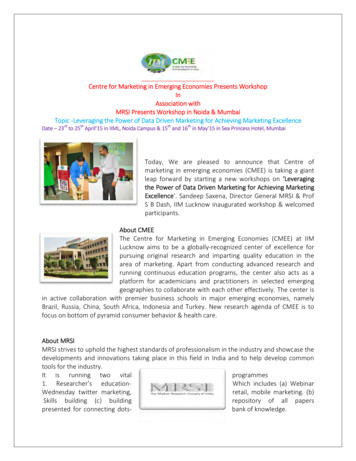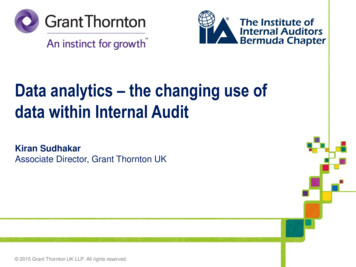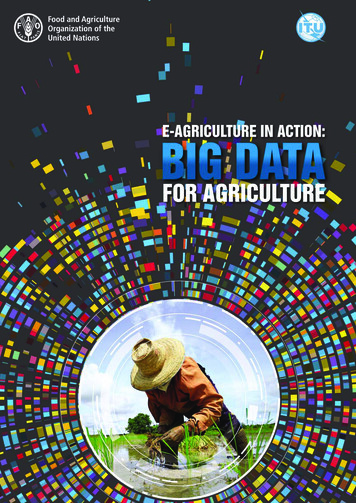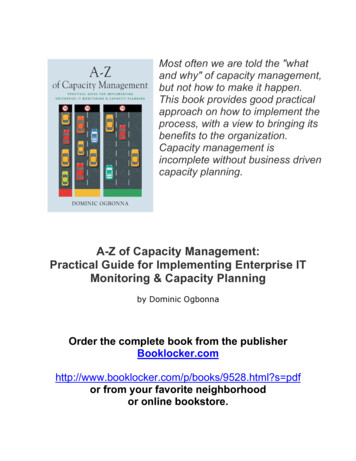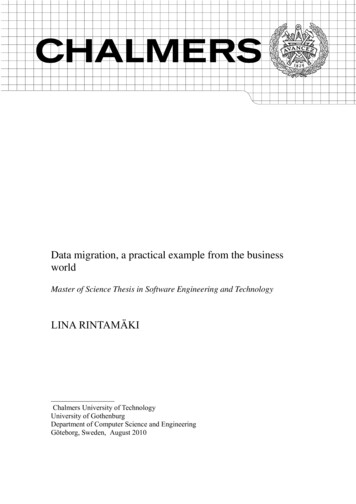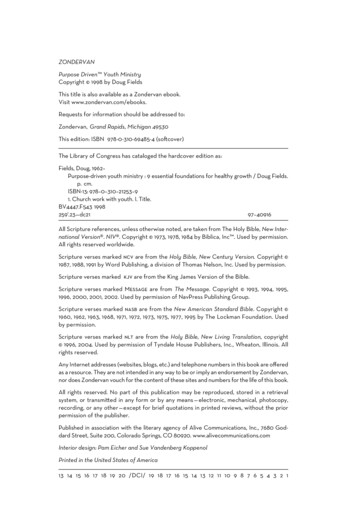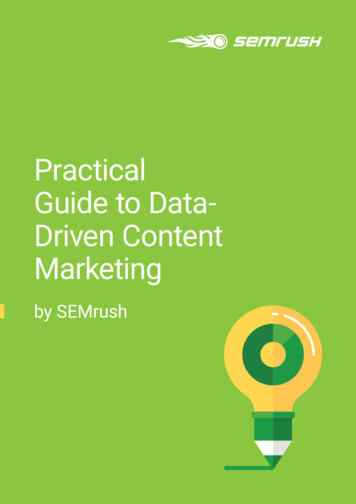
Transcription
PracticalGuide to DataDriven ContentMarketingby SEMrush
Table of СontentIntroductionWho Is This Guide for?What is Data-Driven Content Marketing?Content Marketing Cycle1. Research: Analyse Your Market and Your Competition2. Research: Identify Your Target Audience3. Planning: Set Your Content Marketing Strategy Goals4. Planning: Plan Your Actions5. Creation: Create Relevant Content6. Distribution: Distribute Your Content on the Right Channels7. Perfomance: Analyze Your Perfomance to Improve Your StrategyConclusion
Introduction
4 / 43IntroductionContent marketing has become an essential part of any successful digitalmarketing strategy. However, many content professionals are still unsure of thebest way to create high-quality content.At SEMrush, we know this struggle, as we create both educational and productcontent to help marketers learn how to solve their daily tasks by using ourtools. In order to make headway and strengthen our knowledge, we decided toinvestigate how the content marketing process is organized ‘in the wild’. With thisgoal in mind, our team conducted surveys with experts from around the world(including agencies Re:signal, Invox and 1min30, who we sincerely thank), allowingus to formalize the standard workflow of content marketing professionals.Based on the insights gained, we understand that the key content marketinggoals are to:Create content that delivers value to the desired audience.Ensure content will help to achieve the set marketing goals.At this point, we can state with confidence that high-quality content relies onprecise analytics and trustworthy data. When content is not supported bydata, you can never be sure that it will directly hit the audience’s pain points andcontribute to your objectives.
5 / 43However, the data-driven approach to content marketing is no easy matter andhas specific challenges:1Gathering data takes a lot of time.2Big data is hard to analyze and prioritize.3Data is usually scattered over differents tools, reports and documents,which prevents you from seeing the whole picture.Our research and experience prove that only when this preliminary work, includingdata collection and analysis, is done, does content marketing perform effectivelyand take a good aim.Having learnt this, we created our all-in-one solution — SEMrush ContentMarketing Platform — where content professionals can easily get all thenecessary strategy-building data in one place and make data-informed decisionsthroughout the entire content marketing life cycle.Using all of this experience, we created this guide to help marketers develop andrefine content marketing strategy based on trustworthy data step-by-step.
6 / 43Who Is This Guide for?This guide is developed for:Content Writers — Thisguide allows you to find outwhat exactly to focus onwhile creating content andhow to quickly assess theperformance of your articles.Content Strategists — Thisguide will tell you how toplan your strategy the mostefficient way, discover theessential components, andsee how data helps to makeyour strategy more effectiveand contribute to your overallgoals faster.Editors — You will learn howto plan and create contentthat connects with yourtarget audience and makesure it performs well insearch results.
What is Data-DrivenContent Marketing?7 / 43More than the simple creation and distribution of editorial content, contentmarketing encompasses an entire strategic process. It is deployed at all stagesof the user journey: it should attract visitors, identify prospects, turn theseprospects into customers, and ultimately build their loyalty and integrate theminto your community.To achieve all of these steps in your content marketing, you have to concentrateon the main goal — bringing value to your audience. The data-driven approachallows you to clearly pinpoint exactly what your audience needs, make datainformed suggestions and confirm them confidently instead of moving blindlyin several directions.Data analysis helps you at every step of the content life cycle:1Researching and planning content — helps you to develop the right strategy, whichincludes your target audience and market analysis, define goals and plan your activities.2Creating content — helps you to create content for selected topics that will not onlyanswer your audience’s questions, but also сontribute to your website’s overall visibility.3Distributing content — helps you to discover the right channels to connect with yourtarget audience.4Tracking content performance — helps you to assess the effectiveness of your efforts,test different approaches to your target audience and choose the approach that bestallows you to achieve your goals by bringing value to your target audience.Successful marketing no longer involves going after your prospects with a seriesof one-way messages delivered in bulk. Rather, it’s about engaging your audienceby offering them a personalized experience that they themselves will seek outand share with their peers.
8 / 43“A data-driven content marketing strategy can make all the differencein the world to your success. In fact, you need data if you want to beable to stand out from the crowd and your competitors. Data can tellyou a lot of things that will improve your strategy and your content,from knowing where your audience spends their time online tolearning exactly what kind of content they consume, what keywordsthey use the most and much, much more.Plus, the more you learn about your audience and their needs andpreferences, the easier it will be to create personalized marketingcampaigns and personalized content so that you can ultimatelyconvert more people, faster.”Lilach BullockLead Conversion Expert, Speaker, Content Marketingand Social Media SpecialistIt might sound ambitious, but a solid content marketing strategy backed bydata is essential to the success of your global marketing strategy. Here are themarketing goals you can achieve with a data-driven approach:Generate quality trafficValue-added content that addresses the specific problems or needs of yourtarget audience will improve the flow of relevant visitors, and thus the qualityof your leads.Increase your conversion rateIf you know how to interact with your consumers, address subjects that interestthem, answer their questions, or move and delight them; your products and/orservices will gain in credibility and popularity.Build customer loyalty and grow your communityBy inspiring your customers, making them smile or keeping them on the edge oftheir seat, you’ll turn them into true ambassadors. Content marketing allows youto create a unique world that your customers want to be a part of.
9 / 43Improve your online visibilityThe level of traffic and relevant content sharing are good quality indicators forGoogle. The more engaging your content, the better your SEO ranking - and yourvisibility on search engines!Boost your brand imageContent marketing gives you an opportunity to stand out and declare your brand’sUSP. By refining your digital identity, you get closer to your target audience.Position yourself as an expert in your industryCreating and publishing content allows you to claim your expertise, yourconsulting skills, and your awareness of your audience’s expectations. This willin turn boost brand awareness and inspire trust in your potential customers.The Benefits of Data-Driven Content Marketing in NumbersIn today’s digital age, your potential audience is almost unlimited.A good content marketing strategy allows you to take advantage ofthis opportunity by increasing the number of visitors to your siteby up to 55%.The online visibility of websites offering relevant content alsobenefits: on average, websites gain 434% on pages indexed bysearch engines.Quality content makes your site worthy of being visited. andtherefore recommended. Backlinks are boosted by 97%.Targeted content means attracting qualified prospects. Exploit yourcontent and multiply your leads fivefold.Content marketing will generate a turnover of 300 billion in 2019.even though it costs 62% less than traditional marketing!Sources: DemandMetric, Contently, Deliate Digital
The ContentMarketingCycle
11 / 43The Content Marketing CycleAs you can imagine, setting up an effective content marketing strategy takes planning.While developing the strategy, data analysis allows a content marketer to back up theircreative ideas and suggestions with real figures. Using data, you can prevent yourselffrom wasting time on interacting with the wrong audience, or creating content aboutirrelevant topics, and be capable of setting reasonable and achievable goals.Successful content marketing follows a precise, step-by-step methodology,composed of five key stages:
1. Research: Analyze YourMarket (and Your Competition)12 / 43One of the main objectives of content marketing is to offer a unique experienceto your audience. As such, your first port of call is to examine your competitiveenvironment. What is your industry niche? Who are its leaders? Its influencers?What are your particular strengths as well as your weaknesses? And how do youtransform them into high added-value traits?The most demanding part of a content marketing lifecycle is theresearch up front. I like to plan out my content in advance and duringthe research I need to: Identify/update the personas of the people I want to target; Research the competition; Research keywords/topics; Map out all the content for months in advance; Map out our lead generation process to generate leads through our content; Define the promotion strategy for content;This work takes a lot of time up front but it makes a contentmarketers job a lot easier.Ian ClearyFounder of RazorSocial and Marketing Keynote Speaker
This is just an introductory excerptYou can download the full version driven-content-marketing/
throughout the entire content marketing life cycle. Using all of this experience, we created this guide to help marketers develop and refine content marketing strategy based on trustworthy data step-by-step. However, the data-driven approach to content marketing is no easy matter and has

